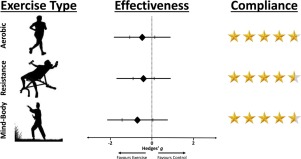Ageing Research Reviews ( IF 13.1 ) Pub Date : 2019-12-11 , DOI: 10.1016/j.arr.2019.100999 Kyle J Miller 1 , Daniela C Gonçalves-Bradley 2 , Pinyadapat Areerob 1 , Declan Hennessy 1 , Christopher Mesagno 1 , Fergal Grace 1

|
Background
Few studies have directly compared the effects of different exercise therapies on clinical depression in older adults. Thus, we conducted a systematic review and network meta-analysis of current evidence from randomised controlled trials (RCTs) to compare the effectiveness of three major exercise types (aerobic, resistance, and mind-body exercise) in clinically depressed older adults.
Methods
We followed PRISMA-NMA guidelines and searched databases for eligible RCTs (inception – September 12th, 2019). RCTs were eligible if they included clinically depressed adults aged >65 years, implemented one or more exercise therapy arms using aerobic, resistance, or mind-body exercise, and assessed depressive symptoms at baseline and follow-up using a validated clinical questionnaire.
Results
A network meta-analysis was performed on 15 eligible RCTs comprising 596 participants (321 treatment and 275 controls), including aerobic (n = 6), resistance (n = 5), and mind-body (n = 4) exercise trials. Compared with controls, mind-body exercise showed the largest improvement on depressive symptoms (g = −0.87 to −1.38), followed by aerobic exercise (g = −0.51 to −1.02), and resistance exercise (g = −0.41 to −0.92). Notably, there were no statistically significant differences between exercise types: aerobic versus resistance (g = −0.10, PrI = −2.23, 2.03), mind-body versus aerobic (g = −0.36, PrI = −2.69, 1.97), or mind-body versus resistance (g = −0.46, PrI = −2.75, 1.83).
Conclusions
These findings should guide optimal exercise prescription for allied health professionals and stakeholders in clinical geriatrics. Notably, clinically depressed older adults may be encouraged to self-select their preferred exercise type in order to achieve therapeutic benefit on symptoms of depression. In coalition with high levels of compliance, these data provide encouraging evidence for the antidepressant effect of either aerobic, resistance, or mind-body exercise as effective treatment adjuncts for older adults presenting with clinical depression.
中文翻译:

三种运动类型对老年人临床抑郁症的比较有效性:随机对照试验的系统评价和网络荟萃分析。
背景
很少有研究直接比较不同运动疗法对老年人临床抑郁的影响。因此,我们对来自随机对照试验(RCT)的当前证据进行了系统的综述和网络荟萃分析,以比较三种主要运动类型(有氧运动,阻力运动和身心运动)在临床抑郁的老年人中的有效性。
方法
我们遵循了PRISMA-NMA指南,并在数据库中搜索了符合条件的RCT(成立于2019年9月12日)。如果RCT包括年龄> 65岁的临床抑郁症成年人,通过有氧,抗性或心身运动实施了一个或多个运动治疗臂,并在基线和随访时使用经过验证的临床调查问卷评估了抑郁症状,则符合RCT的条件。
结果
在15个符合条件的RCT上进行了网络荟萃分析,包括596名参与者(321名治疗者和275名对照),包括有氧运动(n = 6),抵抗力(n = 5)和心身运动(n = 4)。与对照组相比,心身运动对抑郁症状的改善最大(g = -0.87至-1.38),其次是有氧运动(g = -0.51至-1.02)和阻力运动(g = -0.41至-0.92) )。值得注意的是,运动类型之间的差异无统计学意义:有氧运动与阻力运动(g = -0.10,PrI = -2.23,2.03),心身运动与有氧运动(g = -0.36,PrI = -2.69,1.97),或心身与阻力(g = -0.46,PrI = -2.75,1.83)。
结论
这些发现应为临床老年医学领域的专职健康专业人员和利益相关者提供最佳运动处方指导。值得注意的是,可以鼓励临床上沮丧的老年人自行选择他们喜欢的锻炼方式,以便对抑郁症的症状获得治疗益处。在具有高度依从性的联盟中,这些数据提供了令人鼓舞的证据,证明有氧运动,抵抗力或心身运动的抗抑郁作用是对患有临床抑郁症的老年人的有效治疗辅助手段。


























 京公网安备 11010802027423号
京公网安备 11010802027423号